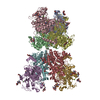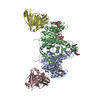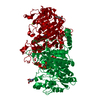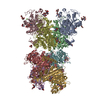[English] 日本語
 Yorodumi
Yorodumi- PDB-7yiv: The Crystal Structure of Human Tissue Nonspecific Alkaline Phosph... -
+ Open data
Open data
- Basic information
Basic information
| Entry | Database: PDB / ID: 7yiv | ||||||
|---|---|---|---|---|---|---|---|
| Title | The Crystal Structure of Human Tissue Nonspecific Alkaline Phosphatase (ALPL) at Basic pH | ||||||
 Components Components | Alkaline phosphatase, tissue-nonspecific isozyme | ||||||
 Keywords Keywords | HYDROLASE / alkaline phosphatase / bone mineralization / catalytic network / hypophosphatasia / structural biology | ||||||
| Function / homology |  Function and homology information Function and homology informationphosphoamidase / phosphoamidase activity / phosphoethanolamine phosphatase activity / pyridoxal phosphate metabolic process / response to vitamin B6 / futile creatine cycle / pyridoxal phosphatase activity / developmental process involved in reproduction / ADP phosphatase activity / biomineral tissue development ...phosphoamidase / phosphoamidase activity / phosphoethanolamine phosphatase activity / pyridoxal phosphate metabolic process / response to vitamin B6 / futile creatine cycle / pyridoxal phosphatase activity / developmental process involved in reproduction / ADP phosphatase activity / biomineral tissue development / pyrophosphatase activity / response to macrophage colony-stimulating factor / inhibition of non-skeletal tissue mineralization / cementum mineralization / Post-translational modification: synthesis of GPI-anchored proteins / alkaline phosphatase / alkaline phosphatase activity / response to sodium phosphate / inorganic diphosphate phosphatase activity / phosphate ion homeostasis / endochondral ossification / cellular homeostasis / response to vitamin D / bone mineralization / calcium ion homeostasis / side of membrane / extracellular matrix / response to glucocorticoid / skeletal system development / response to insulin / mitochondrial intermembrane space / mitochondrial membrane / osteoblast differentiation / positive regulation of cold-induced thermogenesis / response to lipopolysaccharide / response to antibiotic / calcium ion binding / ATP hydrolysis activity / extracellular exosome / extracellular region / membrane / plasma membrane Similarity search - Function | ||||||
| Biological species |  Homo sapiens (human) Homo sapiens (human) | ||||||
| Method |  X-RAY DIFFRACTION / X-RAY DIFFRACTION /  SYNCHROTRON / SYNCHROTRON /  MOLECULAR REPLACEMENT / Resolution: 3.18 Å MOLECULAR REPLACEMENT / Resolution: 3.18 Å | ||||||
 Authors Authors | Cao, Y. / Qin, A. / Yu, Y.T. / Yao, D.Q. / Zhang, Q. / Rao, B. / Xia, Y. / Lu, Y. | ||||||
| Funding support |  China, 1items China, 1items
| ||||||
 Citation Citation |  Journal: Nat Commun / Year: 2023 Journal: Nat Commun / Year: 2023Title: The structural pathology for hypophosphatasia caused by malfunctional tissue non-specific alkaline phosphatase. Authors: Yating Yu / Kewei Rong / Deqiang Yao / Qing Zhang / Xiankun Cao / Bing Rao / Ying Xia / Yi Lu / Yafeng Shen / Ying Yao / Hongtao Xu / Peixiang Ma / Yu Cao / An Qin /  Abstract: Hypophosphatasia (HPP) is a metabolic bone disease that manifests as developmental abnormalities in bone and dental tissues. HPP patients exhibit hypo-mineralization and osteopenia due to the ...Hypophosphatasia (HPP) is a metabolic bone disease that manifests as developmental abnormalities in bone and dental tissues. HPP patients exhibit hypo-mineralization and osteopenia due to the deficiency or malfunction of tissue non-specific alkaline phosphatase (TNAP), which catalyzes the hydrolysis of phosphate-containing molecules outside the cells, promoting the deposition of hydroxyapatite in the extracellular matrix. Despite the identification of hundreds of pathogenic TNAP mutations, the detailed molecular pathology of HPP remains unclear. Here, to address this issue, we determine the crystal structures of human TNAP at near-atomic resolution and map the major pathogenic mutations onto the structure. Our study reveals an unexpected octameric architecture for TNAP, which is generated by the tetramerization of dimeric TNAPs, potentially stabilizing the TNAPs in the extracellular environments. Moreover, we use cryo-electron microscopy to demonstrate that the TNAP agonist antibody (JTALP001) forms a stable complex with TNAP by binding to the octameric interface. The administration of JTALP001 enhances osteoblast mineralization and promoted recombinant TNAP-rescued mineralization in TNAP knockout osteoblasts. Our findings elucidate the structural pathology of HPP and highlight the therapeutic potential of the TNAP agonist antibody for osteoblast-associated bone disorders. | ||||||
| History |
|
- Structure visualization
Structure visualization
| Structure viewer | Molecule:  Molmil Molmil Jmol/JSmol Jmol/JSmol |
|---|
- Downloads & links
Downloads & links
- Download
Download
| PDBx/mmCIF format |  7yiv.cif.gz 7yiv.cif.gz | 749.1 KB | Display |  PDBx/mmCIF format PDBx/mmCIF format |
|---|---|---|---|---|
| PDB format |  pdb7yiv.ent.gz pdb7yiv.ent.gz | 619.6 KB | Display |  PDB format PDB format |
| PDBx/mmJSON format |  7yiv.json.gz 7yiv.json.gz | Tree view |  PDBx/mmJSON format PDBx/mmJSON format | |
| Others |  Other downloads Other downloads |
-Validation report
| Summary document |  7yiv_validation.pdf.gz 7yiv_validation.pdf.gz | 15.1 MB | Display |  wwPDB validaton report wwPDB validaton report |
|---|---|---|---|---|
| Full document |  7yiv_full_validation.pdf.gz 7yiv_full_validation.pdf.gz | 15.3 MB | Display | |
| Data in XML |  7yiv_validation.xml.gz 7yiv_validation.xml.gz | 135.7 KB | Display | |
| Data in CIF |  7yiv_validation.cif.gz 7yiv_validation.cif.gz | 180.9 KB | Display | |
| Arichive directory |  https://data.pdbj.org/pub/pdb/validation_reports/yi/7yiv https://data.pdbj.org/pub/pdb/validation_reports/yi/7yiv ftp://data.pdbj.org/pub/pdb/validation_reports/yi/7yiv ftp://data.pdbj.org/pub/pdb/validation_reports/yi/7yiv | HTTPS FTP |
-Related structure data
| Related structure data |  7yiwC  7yixC  1ew2S S: Starting model for refinement C: citing same article ( |
|---|---|
| Similar structure data | Similarity search - Function & homology  F&H Search F&H Search |
- Links
Links
- Assembly
Assembly
| Deposited unit | 
| ||||||||
|---|---|---|---|---|---|---|---|---|---|
| 1 |
| ||||||||
| Unit cell |
|
- Components
Components
-Protein , 1 types, 8 molecules ADCBGHFE
| #1: Protein | Mass: 57020.188 Da / Num. of mol.: 8 Source method: isolated from a genetically manipulated source Source: (gene. exp.)  Homo sapiens (human) / Gene: ALPL / Production host: Homo sapiens (human) / Gene: ALPL / Production host:  Trichoplusia ni (cabbage looper) Trichoplusia ni (cabbage looper)References: UniProt: P05186, alkaline phosphatase, phosphoamidase |
|---|
-Sugars , 2 types, 32 molecules 
| #2: Polysaccharide | 2-acetamido-2-deoxy-beta-D-glucopyranose-(1-4)-2-acetamido-2-deoxy-beta-D-glucopyranose Source method: isolated from a genetically manipulated source #3: Sugar | ChemComp-NAG / |
|---|
-Non-polymers , 3 types, 32 molecules 




| #4: Chemical | ChemComp-MG / #5: Chemical | ChemComp-ZN / #6: Chemical | ChemComp-CA / |
|---|
-Details
| Has ligand of interest | Y |
|---|---|
| Has protein modification | Y |
-Experimental details
-Experiment
| Experiment | Method:  X-RAY DIFFRACTION / Number of used crystals: 1 X-RAY DIFFRACTION / Number of used crystals: 1 |
|---|
- Sample preparation
Sample preparation
| Crystal | Density Matthews: 2.75 Å3/Da / Density % sol: 55.21 % |
|---|---|
| Crystal grow | Temperature: 293 K / Method: vapor diffusion, sitting drop / pH: 8 Details: 17% (w/v) PEG4000, 30 mM Tris, pH 8.0, 100 mM MgCl2 |
-Data collection
| Diffraction | Mean temperature: 77 K / Serial crystal experiment: N |
|---|---|
| Diffraction source | Source:  SYNCHROTRON / Site: SYNCHROTRON / Site:  SSRF SSRF  / Beamline: BL18U1 / Wavelength: 1 Å / Beamline: BL18U1 / Wavelength: 1 Å |
| Detector | Type: DECTRIS PILATUS3 6M / Detector: PIXEL / Date: Jan 31, 2021 |
| Radiation | Protocol: SINGLE WAVELENGTH / Monochromatic (M) / Laue (L): M / Scattering type: x-ray |
| Radiation wavelength | Wavelength: 1 Å / Relative weight: 1 |
| Reflection | Resolution: 3.17→43.49 Å / Num. obs: 83898 / % possible obs: 98.62 % / Redundancy: 6.7 % / Biso Wilson estimate: 70.29 Å2 / CC1/2: 0.98 / Net I/σ(I): 2.28 |
| Reflection shell | Resolution: 3.2→3.26 Å / Redundancy: 6.5 % / Num. unique obs: 11103 / CC1/2: 0.663 / % possible all: 98.5 |
- Processing
Processing
| Software |
| |||||||||||||||||||||||||||||||||||||||||||||||||||||||||||||||||||||||||||||||||||||||||||||||||||||||||
|---|---|---|---|---|---|---|---|---|---|---|---|---|---|---|---|---|---|---|---|---|---|---|---|---|---|---|---|---|---|---|---|---|---|---|---|---|---|---|---|---|---|---|---|---|---|---|---|---|---|---|---|---|---|---|---|---|---|---|---|---|---|---|---|---|---|---|---|---|---|---|---|---|---|---|---|---|---|---|---|---|---|---|---|---|---|---|---|---|---|---|---|---|---|---|---|---|---|---|---|---|---|---|---|---|---|---|
| Refinement | Method to determine structure:  MOLECULAR REPLACEMENT MOLECULAR REPLACEMENTStarting model: 1EW2 Resolution: 3.18→25.05 Å / SU ML: 0.4 / Cross valid method: THROUGHOUT / σ(F): 1.34 / Phase error: 24.36 / Stereochemistry target values: ML
| |||||||||||||||||||||||||||||||||||||||||||||||||||||||||||||||||||||||||||||||||||||||||||||||||||||||||
| Solvent computation | Shrinkage radii: 0.9 Å / VDW probe radii: 1.11 Å / Solvent model: FLAT BULK SOLVENT MODEL | |||||||||||||||||||||||||||||||||||||||||||||||||||||||||||||||||||||||||||||||||||||||||||||||||||||||||
| Displacement parameters | Biso max: 137.86 Å2 / Biso mean: 68.6681 Å2 / Biso min: 28.54 Å2 | |||||||||||||||||||||||||||||||||||||||||||||||||||||||||||||||||||||||||||||||||||||||||||||||||||||||||
| Refinement step | Cycle: final / Resolution: 3.18→25.05 Å
| |||||||||||||||||||||||||||||||||||||||||||||||||||||||||||||||||||||||||||||||||||||||||||||||||||||||||
| LS refinement shell | Refine-ID: X-RAY DIFFRACTION / Rfactor Rfree error: 0 / Total num. of bins used: 14
|
 Movie
Movie Controller
Controller



 PDBj
PDBj




